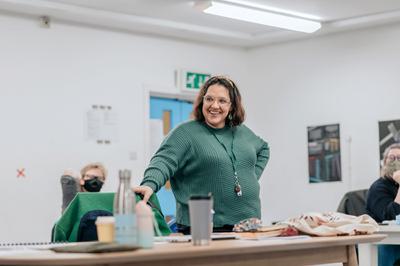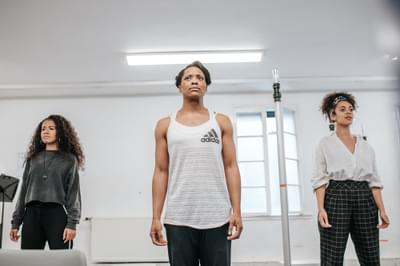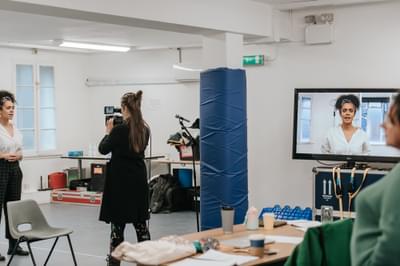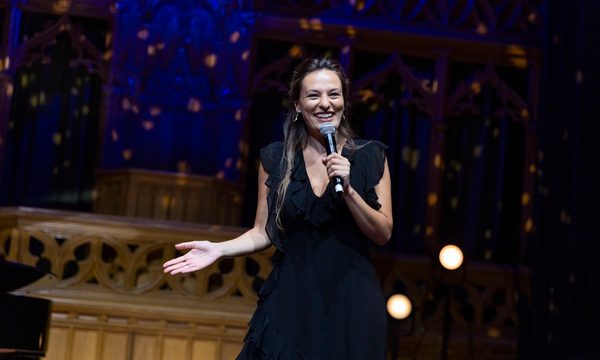
News Story
Award-winning poet and playwright Hannah Lavery’s Lament for Sheku Bayoh tells the tragic story of a young black man from Kirkcaldy in Fife who lost his life in police custody. Lavery’s poignant work is performed by three female actors who mourn for the man, the husband and the father behind the headlines.
Lament for Sheku Bayoh was presented at the 2019 Edinburgh International Festival as a work in development as part of Call and Response. The audience were invited to discuss the work after an intimate performance. Over the last year, the work has been completed and reimagined for a digital audience. Hannah Lavery opens up to Tomiwa Folorunso about this process just before going into an intense period of rehearsals for the performance, which will be streamed from the stage of The Lyceum theatre on 20 and 21 November.

Director and writer Hannah Lavery in rehearsal
© Mihaela BodlovicHow have you found the process of adapting Lament for Sheku Bayoh for a digital space and audience?
We’re still creating a piece of work for the theatre, we are streaming it live, so it will be received in a different space. It feels important that we can share it with more audiences. I’m interested to see, as we start to think about it being filmed and being seen on the screen, what possibilities that opens up for us. But I think it’s still very much a piece of work that exists within the theatre.
The fact that it is a group of women coming together to create this lament for Sheku Bayoh feels important, it feels that that’s the energy it was written in.
The creative team you’re working with are all women, what inspired that decision?
When I was writing Lament I wrote it for three women. So it feels good to have a team of women around it and supporting it. But really the team have come together because they brought the best and I don’t know really if gender was much a part of those discussions. But the fact that it is a group of women coming together to create this lament for Sheku Bayoh feels important, it feels that that’s the energy it was written in. We’ve got the same cast – Saskia Ashdown, Patricia Panther and Courtney Stoddart – that were there in the rehearsed readings and have been there from the beginning. It feels collaborative and it’s a beautiful energy they have together. And predominantly the creative team is women of colour and I think that’s really important, to be speaking from that position – even though those positions are obviously very diverse – I wanted three Scottish women of colour to lament and to keen and to mourn him. To ask us all to mourn.

The cast of Lament For Sheku Bayoh in rehearsal
© Mihaela BodlovicPeople are capable of having great empathy and that I suppose that this work has space for people to come into it.
How was the experience of performing Lament for Sheku Bayoh work in progress at the 2019 International Festival?
It was very different. David Greig supported us, who’s the dramaturg and the director on that. Everything was very minimal. We put it on for three performances and the three actresses and myself went straight into a discussion with quite a stunned audience. There were moments that were quite joyful, moments that were quite difficult and there moments where people got quite heated in their responses, there were reactions I wasn’t expecting from some audience members. I learnt that people are very open, actually, that people are open to exploring ideas and people are capable of changing their minds. People are capable of having great empathy and that I suppose that this work has space for people to come into it. Obviously a lot has happened and this script has changed since then, so some of those lessons have gone in. It was an extraordinary experience.
How has Lament for Sheku Bayoh changed over the last year? Is there a difference in presenting the work in the contexts of 2019 and 2020?
In a lot of ways it was a very different audience in 2019 and that will be interesting to see: if responses have changed and what that sparks. I think more people might know the name Sheku Bayoh now. Some people have said it’s more relevant now. I think we can say that the Black Lives Matter movement has been a movement for a long time, that it’s always been important and it’s sad that it’s taken five years for people to know his name. So maybe the audience has changed, but I think in terms of what I wanted to do, which was to raise some questions and to say his name, I don’t think that’s changed.
If people who come to see this just say his name...
If there is one thing you would want audiences to take away from the work what would it be?
I hope an audience comes open to it. I hope that the audience feel the tragedy of this. When I started writing this a year ago and I told people that I was writing a lament for Sheku Bayoh, the most common reaction I would get was, ‘Sheku who? Who is that? I’ve never heard of that’. So if people who come to see this just say his name, then that for me would be what the purpose of a lament is. That we say his name and we mourn him as a young man and as a father who is no longer here. And if there’s questions raised for people then I hope they have the passion and the energy to go and follow those questions through to seek the answers. I think that’s all I can ask and all I can hope.
How important have artistic opportunities been to you in 2020?
Ghost Light was extraordinary, because that was the first time I’d actually left my house and my wee town. I’m a performer of my work and so I miss performing and I miss reading and I miss being in a space with other artists. So those little opportunities I’ve had, like I did a little extract of Drift for Fringe of Colour and I worked with people on Sorry I’m on Mute, and all of that was just wonderful to have these conversations with other artists. I’m really excited about getting in the rehearsal room with actual people.
When you do something in theatre, you’re not alone. I’m only one part of the process of the story. You’re not standing on a street corner shouting this, you’re surrounded by people that are all saying it with you or standing with you. There’s a strength in it. So it is fearful to say something when you feel that people may disagree or people may be angry about you saying it, but there is a power in telling the truth and I’ve always found solidarity. I’ve always found people that will stand with me.
Lament for Sheku Bayoh is a co-production between National Theatre of Scotland, Edinburgh International Festival and Royal Lyceum Theatre Company. You can book Pay What You Can tickets here.

Saskia Ashdown being filmed while in rehearsal for Lament for Sheku Bayoh
© Mihaela Bodlovic

